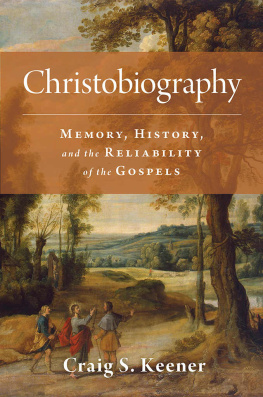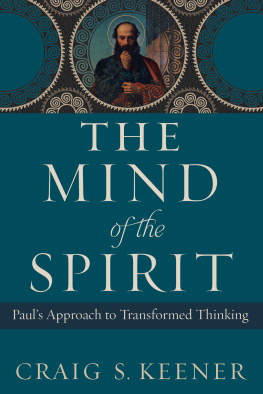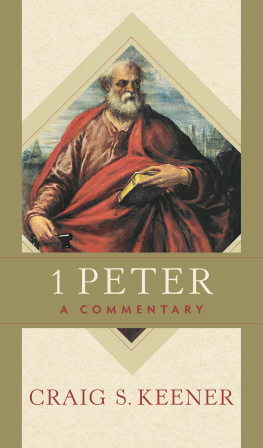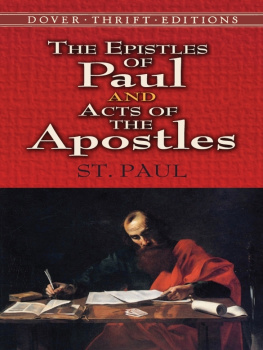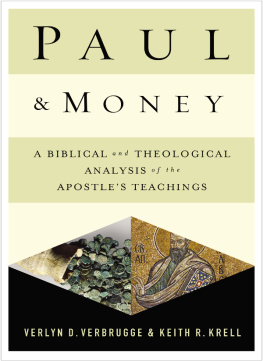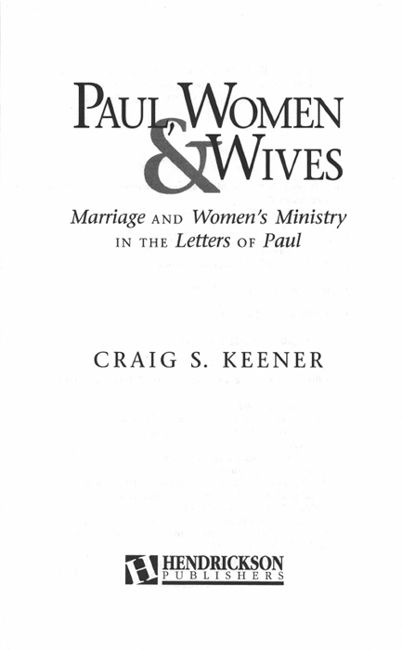
This book is dedicated to all our sisters in ministry, especially those who have had to endure opposition to follow Gods call. May God fulfill all the work of your calling.
1992 by Craig S. Keener
Preface 2004 by Craig S. Keener
Published by Baker Academic
a division of Baker Publishing Group
P.O. Box 6287, Grand Rapids, MI 49516-6287
bakeracademic.com
All rights reserved. No part of this publication may be reproduced, stored in a retrieval system, or transmitted in any form or by any meanselectronic, mechanical, photocopying, recording, or otherwisewithout the prior written permission of the publisher. The only exception is brief quotations in printed reviews.
Ebook edition created 2012
Previously published in 1992 by Hendrickson Publishers. Baker Academic ebook edition created 2012.
ISBN 978-0-8010-4676-6
Library of Congress Cataloging-in-Publication Data is on file at the Library of Congress, Washington, DC.
Table of Contents
Preface (2004)
As Paul, Women, and Wives enters a new printing, I am grateful for the opportunity to revisit some of the issues this work raised and to bring it more up to date. My primary academic interests are exegetical and historical, and I hope to have time in years to come to develop those questions in future commentaries on some of the New Testament letters addressed in this book. (Questions about particular Pauline letters authorship raised by some critical reviewers would also need to be addressed more fully in those works.)
Nevertheless, I also have a pastoral interest in the subject (how we apply Pauls teaching in the twenty-first century), which will not be addressed so easily by purely academic works. Further, most of the response to this book has been theological, and since I am less convinced that I will have opportunity to revisit this books theological questions in future works, I am especially grateful to be able to offer the present preface.
In some circles, debates over the pastoral application of Pauls teachings on gender are settled, but in others they are just warming up. Among those Christians who regard Pauls teaching as authoritative, the debate over gender roles is probably more polarized now than it was when this book was first written. Political and rhetorical battle lines have been drawn, and many Christians have suffered wounds at the hands of fellow Christians. Having no desire to add to the rhetorical bloodshed, I urge readers to take this books insights as an exegetical study with pastoral implications. At the same time, I want to remain clear where I think the pastoral implications point. Since writing Paul, Women, and Wives I have served in ministry under women pastors and alongside women colleagues and am certain that the body of Christ would have been far poorer without the spiritual fruit of their ministry.
In addressing introductory issues where I need to supplement the book, I begin this preface with some comments on gender roles in antiquity (directed more toward advanced students). Then, on a less academic level, I summarize aspects of the shape of the current debate among readers seeking to apply Pauls teaching, especially among evangelicals. Finally I conclude with comments on the hermeneutical principles that necessarily underlie my (and most other egalitarians) approach.
GENDER ROLES IN ANTIQUITY
This section may appeal primarily to specialists, yet it is important for me to include. Scholars have published numerous works on women in both early Judaism and the Greco-Roman world since I completed my original manuscript for Paul, Women, and Wives . A number of these works significantly advance our views of the diverse positions held by women in antiquity. Although they do not alter the central thrust of this book, they would influence how I would write the book if I were starting it today.
Paul, Women, and Wives did note the diverse roles of women, both Jewish and Gentile, in different parts of the Empire, This was an important concern to a minority religious movement in an environment where such movements were sometimes charged with social subversion. On other occasions, however, Pauls statements fit among the most progressive of his contemporaries (as this book emphasizes).
The same may be even more the case for his comments on slavery. Although the wilderness Essenes and some other radical communities rejected slavery in principle (generally because they rejected all private property), the most progressive views expressed among those in mainstream society generally promoted only slaves equality in nature and their fair treatment. By arguing not only for their human equality but for something like mutual submission between slaves and slaveholders (Eph. 6:9), Paul was easily among the more progressive voices of his day.
Where I do not think the evidence points is that everyone, or even most people, would have been as progressive as Paul. Scholars have rightly collected many examples of highly educated upper class women, but those who depend on such collections without reading the entire range of ancient sources will fail to distinguish the exceptions from the general practice. (A person actually surveying the ancient sources directly will recognize that the preponderance of sources do not suggest anything close to gender equality.) Likewise, Jewish women attended synagogue and learned the law, but, with possibly rare exceptions, were not raised to recite it the way most boys were. While we should take note of the exceptions (which provide a context for the many exceptions also in the New Testament), we should not lose sight of the fact that these were (in most of the Empire) exceptions.
Although we know of women in positions of prominence, they constituted a far smaller percentage than men. Of course, the same is true in Paul: the women in visible ministry were a small percentage compared to the men in such ministry, and their percentage tended to be higher in locations (and perhaps classes or occupations) where women had more social freedom. But the point must be that Paul approved of these womens activities, in contrast to the tendencies of a good number of his contemporaries. Likewise, while there is plenty of evidence for diverse positions in different parts of the Mediterranean world, none of these suggest a society that would allow women to vote or to engage in activities alongside men in the way that almost all of us (at least in western society and some other cultures) take for granted today. Again, it may be objected that Paul does not, so far as we have record, press beyond his society by advocating womens (or anyones) suffrage; he addressed the issues of his culture. But again, I stand by my argument in this book that Paul does make statements about gender (such as Rom. 16:13, 67, 12; 1 Cor. 11:5, 1112; Gal. 3:28;
We may compare Paul, for instance, with the much earlier writer Xenophon, who was also very progressive. Various ancient writers spoke of forms of mutuality while preserving (in various degrees) a measure of hierarchy (an observation important, for example, in the exhortation to children in Eph. 6:13). Xenophons position restricts women more than most complementarians (gender hierarchicalists) would today; but he has moved significantly beyond the typical views of his Athenian contemporaries, and it is in this context that we must judge him historically.
Paul does move beyond such statements in emphasizing mutual submission (Eph. 5:21), and this contrast is instructive, but should not be overstated. On the one hand, the statement of mutual submission in Ephesians 5 is so directly connected with the wifes submission as to challenge his societys usual understanding of that relationship. On the other, Paul presumably did expect wives to honor the accepted roles of their society for the sake of the gospel (as he also expected submission to other authorities in the society). As I suggest in the last three chapters of this book, that is presumably the reason for his household codes.
Next page


